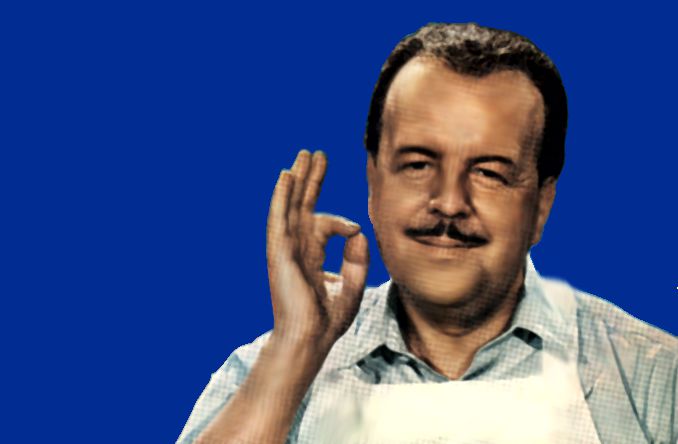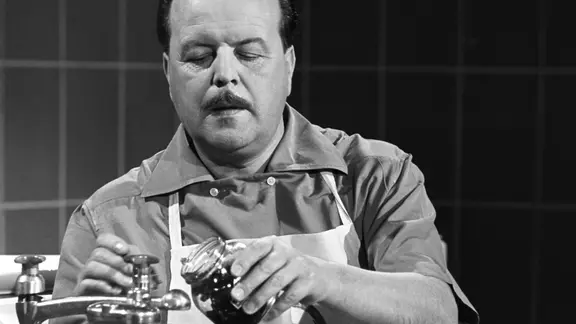Who is Clemens Wilmenrod The Invented German TV Chef

In the annals of culinary history, few figures are as fascinatingly paradoxical as Clemens Wilmenrod. He was a television pioneer, a household name, and a trusted culinary guide to millions of Germans in the 1950s. Yet, the sophisticated aristocrat he portrayed on screen was a complete fiction, an elaborate character brought to life by a talented actor, forever blurring the lines between reality and performance in the emerging world of food media.
Quick Bio
| Quick Bio: Clemens Wilmenrod | |
|---|---|
| Full Name | Clemens Wilmenrod (Character) / Werner Pfeiffer (Actor) |
| Occupation | Television Chef, Radio Personality, Actor |
| Born (Actor) | December 18, 1909 (Mainz, Germany) |
| Died (Actor) | October 12, 1985 (Wiesbaden, Germany) |
| Nationality | German |
| Famous For | Being Germany’s first TV chef, inventing Toast Hawaii |
| Key Show | “Bitte in 10 Minuten zu Tisch” (Dinner in 10 Minutes, Please) |
| Culinary Style | Theatrical, convenience-food based, “exotic” fusion |
| Legacy | Pioneered the TV cooking show format, became a kitsch icon |
| Status | Fictional character portrayed by Werner Pfeiffer |
Who Really Was Clemens Wilmenrod?

To understand the phenomenon, one must look behind the bowtie and tuxedo. The man known to the public as Clemens Wilmenrod was, in reality, Werner Pfeiffer, a gifted and versatile entertainer born in Mainz in 1909. Before donning the chef’s hat, Pfeiffer had built a respectable career as a radio announcer, actor, and cabaret artist. He was a man of the stage and microphone, skilled in the art of performance and character work. The creation of Wilmenrod wasn’t a random act but a calculated move by a professional who understood post-war audiences craved not just recipes, but a story and an escape. Pfeiffer conceived the character, crafted his aristocratic backstory, and perfected his mannerisms, effectively becoming the first true “food personality”—a concept that was entirely new at the time.
Early Life and Background: Forging an Aristocrat

The backstory of Clemens Wilmenrod was as carefully prepared as his dishes. Presented to the public as a well-traveled gentleman from the Rhineland nobility, Wilmenrod spoke of grand adventures and culinary experiences from around the globe. This fictional biography was a key ingredient in his recipe for success. In stark contrast, Werner Pfeiffer’s own background was far more modest and rooted in the practical world of entertainment. He was not an aristocrat but a working actor, a man who understood the rhythms of comedy and drama. This deliberate contrast between the character’s lofty origins and the actor’s grounded profession highlights the sheer brilliance of the performance. Pfeiffer wasn’t just playing a chef; he was embodying an ideal—the sophisticated, worldly expert who could guide a nation out of culinary austerity.
Age and Physical Appearance: The Image of Distinction
Clemens Wilmenrod’s power lay as much in his visual presentation as in his cooking. He appeared on screen as a man in his confident late forties or early fifties, his age lending him an air of experience and authority. His physical appearance was meticulously curated to project distinction and trust. Unlike the image of a sweaty chef toiling in a kitchen, Wilmenrod was the picture of unflappable elegance. He was always impeccably dressed in a full suit or, most iconically, a tuxedo with a perfectly tied bowtie. His hair was slicked back neatly, and his demeanor was calm, serious, and slightly stern. This wasn’t a man who was cooking out of necessity; he was a gentleman-scholar of food, graciously demonstrating his knowledge for the benefit of the viewer. This projection of upper-class sophistication was utterly captivating for a population eager to embrace modernity and refinement.
His Chef Career Beginnings: From Radio to the Kitchen

The journey to becoming Germany’s first TV chef began not on screen, but on the airwaves. Werner Pfeiffer first introduced his Clemens Wilmenrod character on a radio show called “Bitte in 10 Minuten zu Tisch” (“Dinner in 10 Minutes, Please”). The format was perfect for the character’s strengths: a calm, authoritative voice describing simple yet seemingly luxurious dishes that could be prepared quickly. Radio allowed the audience to fully buy into the fictional aristocratic persona without visual distractions. His success there made him a natural candidate for the new medium of television. When he made the transition, the character was already established. Television simply added the powerful visual layer—the tuxedo, the stern yet friendly face, the theatrical flourish of his cooking style—catapulting him from a voice on the radio to a national superstar in the living room.
Rise to Fame: Germany’s First TV Chef
Clemens Wilmenrod’s rise to fame was a perfect alignment of character, medium, and moment. In the 1950s, the German Wirtschaftswunder (economic miracle) was underway. The nation was rebuilding, and families were acquiring new appliances and looking toward a brighter, more modern future. Television sets were becoming more common, and broadcasting was finding its feet. Into this hopeful landscape stepped Wilmenrod. He offered a potent form of escapism: elegance, exoticism, and a touch of glamour. His calm, authoritative delivery made him a trusted figure. Housewives and families saw him not as a mere entertainer, but as a reliable expert who could guide them through the unfamiliar territory of international and modern cuisine. He didn’t just teach people how to cook; he sold them a dream of a more sophisticated life.
Signature Dishes and Culinary Style: The “Wilmenrod” School of Cooking
The culinary style of Clemens Wilmenrod was unique. It was less about classic French technique or traditional German heartiness and more about spectacle, novelty, and the clever use of new convenience foods. His creations were designed to be visually impressive on camera and achievable for the home cook, often relying on canned and packaged goods that symbolized post-war modernity.
- The Toast Hawaii: This is his undisputed legacy. A seemingly simple combination of a slice of toast, ham, canned pineapple, a maraschino cherry, and melted cheese, it became a cultural touchstone. It was sweet, salty, hot, and cold—a riot of flavors and textures that felt incredibly exotic and modern to the German palate of the time.
- The Bombe Alaska: This dessert was a perfect example of his theatrical style. Flambéing ice cream provided a stunning visual spectacle for television, making it the ultimate party trick for aspiring hostesses. It embodied the drama and excitement he brought to cooking.
- Cooking with Canned Goods: Wilmenrod was a champion of the modern pantry. He unapologetically used canned fruits, vegetables, and meats, reflecting the era’s growing fascination with convenience and shelf-stable products. This democratized his cooking, making “gourmet” experiences accessible to everyone.
Controversies and Criticism: Clashing with the Culinary Establishment
Inevitably, such a meteoric rise and unorthodox approach attracted significant backlash. The controversies and criticism directed at Clemens Wilmenrod were fierce. Traditional chefs, gourmets, and food purists were appalled. They decried his recipes as vulgar, inauthentic, and a grotesque corruption of proper German and international cuisine. They saw Toast Hawaii as an abomination—a sugary insult to the culinary arts. To the establishment, he was a fraud in a tuxedo, a dangerous charlatan leading the public’s taste astray. This clash highlighted a deep cultural divide between the old guard, who valued tradition and technique, and the new, modern world of convenience, media, and accessibility that Wilmenrod represented.
Later Years and Decline: The End of an Era
All phenomena have their season, and the Clemens Wilmenrod character was no exception. By the early 1960s, the novelty began to wear off. The German economic miracle had firmly taken hold, and with it, the public’s tastes evolved. Travel became more common, and authentic Italian and French restaurants began to proliferate. Audiences started seeking more genuine culinary experiences and knowledge, moving beyond the theatrical convenience of Wilmenrod’s offerings. New, more serious cooking shows began to emerge, hosted by chefs with formal training. The character that had once seemed so modern began to feel dated and gimmicky. Werner Pfeiffer wisely retired the Wilmenrod persona, allowing it to fade from the spotlight before it could become a complete parody of itself.
Legacy and Influence: The Unexpected Pioneer
Despite the criticism and eventual decline, the legacy and influence of Clemens Wilmenrod is profound and undeniable. He was a true pioneer. He essentially invented the format of the television cooking show in Germany. Every food personality who has since graced German screens, from Alfred Biolek to Tim Mälzer, owes a debt to his groundbreaking work. He demystified cooking for a generation of housewives, presenting it as an accessible and even glamorous activity. Most importantly, he introduced a sheltered, post-war nation to the idea of “international” food, no matter how interpreted. He opened the door to culinary experimentation and made it acceptable to break from tradition, forever expanding the German culinary horizon.
Death and Posthumous Recognition: The Man and the Character
Werner Pfeiffer, the talented actor behind the icon, passed away in Wiesbaden in 1985. However, the character of Clemens Wilmenrod has enjoyed a remarkable posthumous recognition. He is no longer seen through the lens of the old controversies but is remembered with a fond, ironic nostalgia as a beloved kitsch icon. Toast Hawaii has undergone a similar revival, now celebrated as a comforting, retro dish that embodies a specific, optimistic moment in German history. Wilmenrod is recognized not as a fraud, but as a brilliant and foundational piece of German pop culture—a symbol of a nation’s eager, if sometimes awkward, first steps into modernity and global culture.
Conclusion: The Gentleman Who Cooked a Fantasy
The story of Clemens Wilmenrod is about much more than pineapple on toast. It is a story about the power of television, the need for escapism, and the creation of identity in a post-war world. He was a complete fiction who satisfied a very real hunger—not just for food, but for glamour, innovation, and a brighter future. Werner Pfeiffer’s creation gave a nation permission to dream, to experiment, and to find joy in the simple, theatrical act of cooking. He was the gentleman who cooked a fantasy, and in doing so, he left an indelible and surprisingly sweet mark on the German culinary landscape.
FAQs
What is Clemens Wilmenrod most famous for?
He is most famous for inventing Toast Hawaii and for being Germany’s very first television cooking show host in the 1950s.
Was Clemens Wilmenrod a real chef?
No, he was not a trained chef. He was a fictional character played by the actor and entertainer Werner Pfeiffer. His culinary authority was part of the performed act.
What was the name of Clemens Wilmenrod’s show?
His most famous show was called “Bitte in 10 Minuten zu Tisch” (“Dinner in 10 Minutes, Please”), which aired on both radio and television.
Why was Clemens Wilmenrod controversial?
Traditional chefs and food purists heavily criticized him for his recipes, which they considered inauthentic and a corruption of true cuisine, especially his use of canned goods and sweet-and-savory combinations.
Is Toast Hawaii actually German?
Yes, despite its tropical name and ingredients, Toast Hawaii was invented in Germany in the 1950s by Clemens Wilmenrod and has become a classic of German retro Gemütlichkeit (coziness).
For More Info Visit: The Hollywood Reporters




